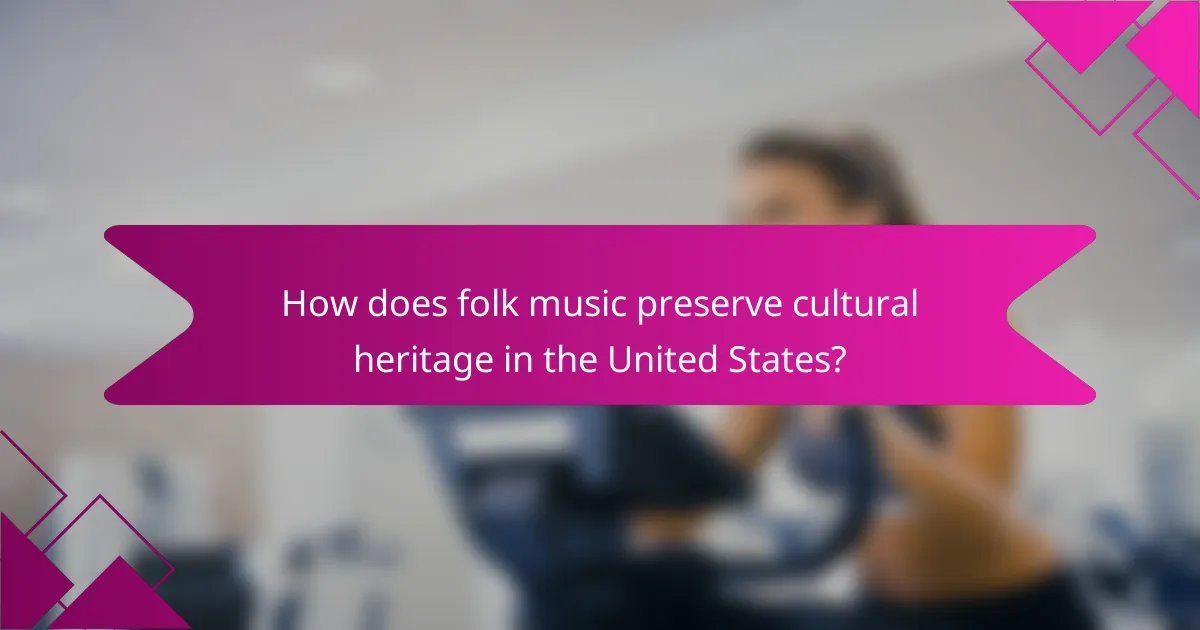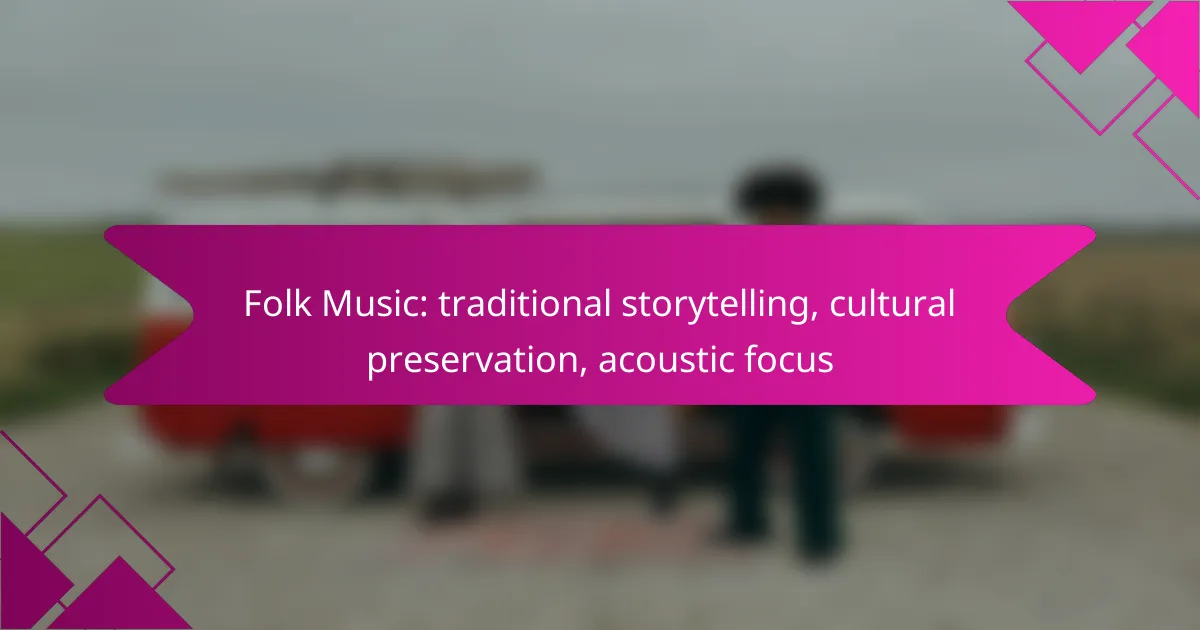Folk music is essential for preserving cultural heritage, as it captures and shares the stories, traditions, and values of diverse communities. With its acoustic focus and emphasis on storytelling, this genre acts as a living archive, reflecting the unique identities and histories of its origins.

How does folk music preserve cultural heritage in the United States?
Folk music plays a crucial role in preserving cultural heritage in the United States by capturing and transmitting the stories, traditions, and values of various communities. Through its acoustic focus and traditional storytelling, folk music serves as a living archive of cultural identity and history.
Storytelling through songs
Folk music serves as a powerful medium for storytelling, often conveying tales of love, hardship, and community experiences. Songs frequently reflect historical events, social issues, and personal narratives, allowing listeners to connect with the past. For example, ballads about the American Civil War or the Great Depression provide insights into the struggles and resilience of those eras.
These narratives are often passed down through generations, evolving with each rendition while maintaining core themes. This oral tradition ensures that stories remain relevant and accessible, fostering a sense of continuity within communities.
Community engagement and identity
Folk music fosters community engagement by bringing people together through shared experiences and collective participation. Local festivals, sing-alongs, and workshops create spaces for individuals to connect, celebrate their heritage, and strengthen their cultural identity. This communal aspect is vital in maintaining traditions and encouraging younger generations to embrace their roots.
Moreover, folk music often reflects the unique characteristics of specific regions, incorporating local dialects, instruments, and styles. This regional diversity enriches the cultural tapestry of the United States, allowing different communities to showcase their distinct identities while contributing to a broader national narrative.
Influence on contemporary music
The influence of folk music on contemporary genres is significant, as many modern artists draw inspiration from traditional folk elements. Genres such as Americana, indie folk, and even pop often incorporate acoustic instruments and storytelling techniques rooted in folk traditions. This blending of styles helps keep folk music alive while introducing it to new audiences.
Additionally, contemporary artists often reinterpret classic folk songs, bringing fresh perspectives and relevance to timeless narratives. This ongoing dialogue between past and present not only preserves cultural heritage but also ensures its evolution within the modern musical landscape.

What are the key characteristics of traditional folk music?
Traditional folk music is characterized by its acoustic instrumentation, storytelling lyrics, and regional variations that reflect the culture and history of specific communities. It serves as a means of cultural preservation, often passed down through generations, and emphasizes the experiences of everyday life.
Acoustic instrumentation
Traditional folk music primarily utilizes acoustic instruments, which contribute to its organic sound. Common instruments include the guitar, banjo, fiddle, accordion, and various percussion instruments. These instruments are often played in a way that highlights their natural tones, creating a warm and inviting atmosphere.
In many cultures, the choice of instruments can vary significantly, reflecting local traditions and available materials. For example, in Eastern European folk music, you might find the use of the balalaika or cimbalom, while in American folk, the mandolin and harmonica are more prevalent.
Lyric themes of everyday life
The lyrics of traditional folk music often focus on themes of everyday life, including love, hardship, work, and community. These songs tell stories that resonate with listeners, capturing the essence of human experiences and emotions. The narratives are typically straightforward, making them accessible to a wide audience.
Many folk songs serve as a form of oral history, preserving the tales and traditions of a community. For instance, sea shanties recount the lives of sailors, while Appalachian ballads reflect the struggles and joys of rural life in the United States.
Regional variations
Folk music varies greatly by region, with each area developing its own unique style and sound. These regional variations are influenced by local history, culture, and the specific instruments used. For example, Irish folk music is known for its lively jigs and reels, while American folk music often incorporates blues and country elements.
Understanding these regional differences can enhance appreciation for folk music. Listeners may notice distinct rhythms, scales, and lyrical styles that reflect the cultural identity of the area. Engaging with local folk traditions can provide deeper insights into the community’s values and history.

How can digital platforms enhance folk music accessibility?
Digital platforms significantly improve access to folk music by providing a wide array of resources for listening, learning, and participating in the genre. These platforms break down geographical barriers, allowing enthusiasts to discover traditional sounds and stories from various cultures around the world.
Streaming services like Spotify
Streaming services such as Spotify offer extensive libraries of folk music, making it easy for listeners to explore different styles and artists. Users can create playlists, follow their favorite musicians, and discover new tracks through curated recommendations based on their listening habits.
Additionally, many streaming platforms feature podcasts and documentaries that delve into the history and cultural significance of folk music, enriching the listener’s experience. Subscriptions typically range from free ad-supported versions to premium plans that provide offline listening and higher audio quality.
Online courses for learning instruments
Online courses provide an accessible way for individuals to learn folk instruments, such as the banjo, fiddle, or acoustic guitar. Platforms like Udemy or Coursera offer structured lessons that cater to various skill levels, often featuring video tutorials and interactive exercises.
Many courses are affordable, with prices ranging from free to around $100, depending on the depth of content. Learners can also benefit from community forums where they can share progress and seek advice, fostering a sense of connection to the folk music tradition.
Virtual folk music festivals
Virtual folk music festivals have emerged as a popular way to celebrate and share folk culture globally. These online events often feature live performances, workshops, and discussions with artists, allowing audiences to engage with the music from the comfort of their homes.
Tickets for virtual festivals are generally more affordable than in-person events, often costing between $10 to $50, making them accessible to a wider audience. Attendees can enjoy diverse programming that showcases both established and emerging folk artists, promoting cultural preservation and appreciation.

What role do folk music festivals play in cultural preservation?
Folk music festivals are vital for cultural preservation as they celebrate and promote traditional music, ensuring that these art forms are passed down through generations. By bringing together artists and audiences, these festivals create a vibrant space for cultural exchange and community bonding.
Showcasing traditional artists
Folk music festivals provide a platform for traditional artists to perform, allowing them to share their unique styles and stories with a wider audience. This exposure helps to keep their music alive and relevant, often leading to increased interest in their cultural heritage.
Many festivals feature competitions or showcases specifically for traditional musicians, which can lead to opportunities for recording contracts or collaborations. This recognition not only benefits the artists but also highlights the importance of preserving their musical traditions.
Promoting local culture
These festivals often celebrate the local culture by incorporating regional music, dance, and food, creating an immersive experience for attendees. This focus on local traditions fosters a sense of pride among community members and encourages them to engage with their cultural roots.
Additionally, folk music festivals can attract tourists, which boosts the local economy while promoting cultural awareness. By showcasing local artists and traditions, festivals help to solidify a community’s identity and cultural significance.
Encouraging intergenerational participation
Folk music festivals often attract a diverse audience, including families and individuals of all ages, which encourages intergenerational participation. Workshops and activities designed for children and adults alike help bridge the gap between generations, fostering a shared appreciation for traditional music.
By involving younger generations in the festival experience, organizers can instill a sense of responsibility for preserving their cultural heritage. This engagement can lead to the revival of traditional practices and the continuation of storytelling through music, ensuring that these traditions endure for years to come.

How can educators incorporate folk music into their curriculum?
Educators can effectively incorporate folk music into their curriculum by using it as a tool for cultural exploration and engagement. This approach not only enhances students’ understanding of cultural history but also fosters language skills and creativity through interactive activities.
Teaching cultural history through music
Folk music serves as a rich resource for teaching cultural history, as it often reflects the traditions, values, and stories of a community. Educators can select songs that highlight significant historical events or cultural practices, providing context and background to enhance students’ learning experiences.
For example, a lesson on American history could include folk songs from different eras, such as Civil War ballads or labor songs, allowing students to connect emotionally with the past. This method encourages critical thinking as students analyze the lyrics and their historical significance.
Using folk songs in language learning
Folk songs can be a powerful tool in language learning, as they often feature repetitive structures and simple vocabulary. Educators can use these songs to teach pronunciation, rhythm, and vocabulary in a fun and engaging manner.
For instance, using traditional folk songs in Spanish or French can help students practice their language skills while immersing them in the cultural context of the language. Singing along with the music can improve fluency and retention, making language acquisition more enjoyable.
Engaging students with hands-on activities
Incorporating hands-on activities related to folk music can significantly enhance student engagement. Activities such as creating instruments, composing original folk songs, or performing traditional dances allow students to actively participate in the learning process.
For example, students could work in groups to research a specific folk song, create their own version, and present it to the class. This collaborative approach not only fosters teamwork but also deepens their appreciation for the cultural significance of folk music.

What are the benefits of learning folk music instruments?
Learning folk music instruments offers numerous benefits, including enhanced cognitive abilities, cultural appreciation, and improved social connections. Engaging with folk music not only fosters creativity but also helps preserve cultural heritage through traditional storytelling.
Enhancing cognitive skills
Learning to play folk music instruments can significantly enhance cognitive skills such as memory, attention, and problem-solving. The process of mastering an instrument involves reading music, coordinating movements, and understanding rhythm, all of which stimulate brain activity.
For instance, studies suggest that musicians often demonstrate improved memory retention and faster information processing compared to non-musicians. Regular practice can lead to better multitasking abilities and heightened focus, which are beneficial in both academic and professional settings.
To maximize these cognitive benefits, set aside regular practice time, ideally 30 minutes to an hour daily. This consistency helps reinforce learning and skill development, making the most of your time spent with the instrument.
